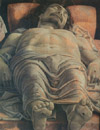|
|
Apartments in Florence, Perugia, Rome, Sorrento and Positano |




|
|
|
|
- You are in: Home » Tuscany » San Gimignano
VISIT SAN GIMIGNANO
« All the regions
COLLEGIATA CATHEDRAL
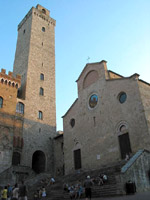
The Chiesa Collegiata is the main church of San Gimignano, situated in the Piazza del Duomo
at the town's heart. It was once the "Duomo" (cathedral), but since San Gimignano no longer
has a bishop it has reverted to the status of a collegiate church. The first church on the site was
begun in the 10th century. The present building was begun in the early 12th century and was
consecrated by Pope Eugene III in 1148. It was altered and enlarged by Giuliano da Maiano
between 1466 and 1468. The façade dates from 1239 and is remarkably plain. The Pisan Romanesque
interior is famous for its lavish frescoes, which almost entirely cover the walls. The arcades are
of black and white striped marble. In the centre is a large fresco of "St Sebastian" by Benozzo
Gozzoli (1465), commissioned after the plague had hit the town in 1464. A fresco cycle by
Taddeo di Bartolo depicts the "Last Judgement" in gruesome detail. There are also cycles of
the "Old Testament" by Bartolo di Fredi (1356â1367) and the "New Testament", traditionally
attributed to Barna di Siena (who supposedly died in a fall from the scaffolding while
painting them), but possibly by Lippi Memmi (begun in 1333). The two main chapels are the
"Cappella di San Gimignano", with an altar by Benedetto da Maiano, and the "Cappella di Santa
Fina", designed by Giuliano da Maiano, with the sculpture by his brother Benedetto.
Domenico Ghirlandaio painted the frescoes in the latter chapel. St Fina was born in San
Gimignano in 1238, contracted an incurable disease when she was ten and spent the five years until
her death lying on a board to increase her suffering before God. On her death the board was covered
in flowers. The house where she supposedly lived and died still stands in the town.
top
CASTLE AND FORTRESS
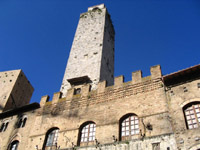
The Castle became the Fortress that defended the youthful Commune from the beginning of the 13th century until 1353, when Florence after having defeated the town, decided to build a second Fortress, on the hill of Montestaffoli, just above the Cathedral. Only a few shattered remains are left of this Fortress ("Rocca") but its highest point offers one of the most beautiful views of the towers of San Gimignano. The ancient Castle was thus abandoned and was later taken over by the Dominican order who transformed it into a monastery, the Chapel of which is still in good condition, with its great carved and gilded wooden Baroque altar. Towards the end of the 18th century, the Dominicans moved out and in due course the Castle became a men`s prison (1844). This great structure, however, will shortly be restored. One of the most recent discoveries in the centre of the courtyard is an Etruscan "hypogeum" (underground tomb). A new prison has just been built outside the town and one hopes that the ancient complex will be put to more culturally appropriate uses in the not too distant future. Next to the Castle, at the end of Via San Giovanni, we find the much altered and restored Church of San Lorenzo in Ponte, a Romanesque structure, built in 1240. On the walls, a cycle of frescoed Stories of St. Benedict is still fairly legible, whilst a great scene of the Damned is unfortunately very damaged, the apse semicircle contains an equally extensive frescoed scene showing Christ in Glory with the Madonna and the twelve Apostles; the style which is still very Gothic, is that of the Florentine, Cenni di Francesco di SerCenni, and was painted around 1413.
top
CATHEDRAL SQUARE
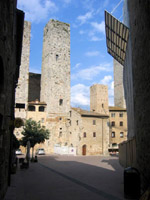
The heart of the town is the Cathedral Square, where the three most important medieval buildings in the town face each other across its stone flags: the Cathedral of the Collegiata, the old Palace of the Podesta and the Palace of the Commune (or New Palace of the Podesta). The elder of the two latter buildings faces the Cathedral from the opposite side of the square. It used to be the residence of the Podesta and his family and it was the seat of the Council. It is one of the oldest structures in town, surmounted by its 13th century tower known as the "Rognosa" (Scurvy), which is 51 meters high. The Statutes of 1255 established that no other tower should be higher than the tower of the palace of the Podesta, the only exception being the "Torre Grossa" (Great Tower) of the Palace of the Commune which is 53 metres high. On the ground floor of the Palace of the Podesta, there is a kind of great porch covered by a spacious vaulted ceiling and surrounded by stone wall benches. On the end wall there are dilapidated traces of a fresco painted by Sodoma in 1513, showing the "Madonna and Child between Saints Nicholas and Gimignano". Inside, the palace was restructured in 1534 with a view to building a theatre within the palace, that was to be totally retransformed in 1794 by Francesco Marinelli and is today completely abandoned. The battlements at the top of the facade are also a recent addition. Palazzo Paltoni-Salvucci, with its twin towers is to the left of the Cathedral steps, if one is facing downhill. On the other side of the street, one can find the elegant Palazzo Useppi-Chigi, with its late 13th century tower.
top
PALAZZO COMUNALE
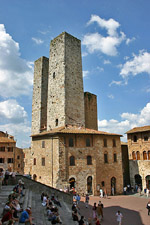
In the Cathedral square we find the Palace of the Commune. It was started towards the end of the 13th century and enlarged around the middle of the following century. According to a fairly founded tradition, the architect responsible for its design is supposed to have been Arnolfo di Cambio, the great Florentine master. The so-called Haranguing Podium ("Arringo") sticks out from the fagade on the right beneath the great tower and is led up to by two flights of steps from the sides. To the right of the palace is the so-called Torre Grossa (Great Tower), entirely built in travertine and 54 metres high; it was completed in 1311. Left of the building, is the great double-arched loggia that was completed in 1347 and restored to its original appearance in 1934 after it had been walled-up in the 16th century.
top
MUSEUM OF RELIGIOUS ART
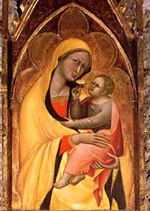
This is where a large number of stone or marble items are displayed, which used either to be in the Collegiata or in other religious buildings in the San Gimignano area. See for instance: the badges, tomb-stones, column-bearing lions, water-stoups, reliefs and even a chair used by the wet-nurses during the baptisms. A number of 14th and 15th century objects complete the collection. There is also a fine painted wooden Crucifix above the chapel altar, which is either late 14th or early 15th century. In the Archaeological Museum a large number of archaeological finds from the area around San Gimignano have been placed in a large chamber and are to be better displayed in future. Most of the objects come from the Etruscan tombs of the district {plates, bowls, vases, lamps, axes, spears, mirrors, golden rings, stone sarcophagi, etc.)
top
|
|
|
|
|
|
| TOP DESTINATIONS
|
| Adria Coast, Aeolian Islands, Alessandria, Altopiano Delle Rocche, Amalfi Coast, Aosta, Assisi, Asti, Bari, Brescia, Capo Vaticano, Capri, Catanzaro, Chianti, Cilento, Cinque Terre, Coast Of Marche, Conero Coast, Dolomites, Egadi Islands, Elba, Florence, Garda Lake, Gargano, Ischia, Italian Riviera, Lake Como , Langhe Piedmont, Lecce, Lucca, Lunigiana, Macerata, Mantova, Maremma Tuscany, Monferrato, Montepulciano, Naples, Perugia, Pesaro Urbino, Pisa, Pistoia, Positano, Prato, Procida, Riviera Of Palms, Rome, Salento Coast, Salerno, San Gimignano, Sardinia, Sicily, Siena, Sorrento, Terni, Tiber Valley Of Tuscany, Treviso, Turin, Val Gandino, Veneto, Venice, Viterbo |
|
|








